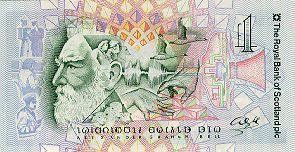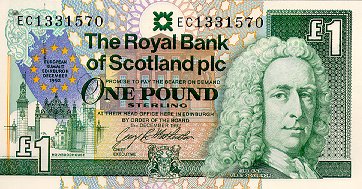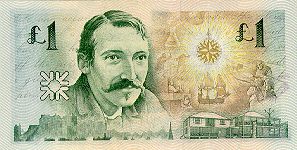
Royal Bank of Scotland Pound Note to mark the 150th Anniversary of the Birth of Alexander Graham Bell (Reverse)
On 3 March 1997, The Royal Bank of Scotland issued 2 million commemorative banknotes to mark the 150th anniversary of the birth of one of Edinburgh's most famous sons. Alexander Graham Bell was born in Edinburgh in 1847 at 14 South Charlotte Street in the west end of Princes Street in the elegant Georgian New Town.
Like his father, he became a teacher of the deaf but after working in schools in the north of Scotland and Edinburgh he emigrated at the age of 23 to Canada and on to Boston in the hope of escaping tuberculosis (which had claimed both his brothers). It was there in 1875 that his studies in the mechanics of sound led him to produce the world's first telephone, excitedly calling his assistant Mr Watson with the classic words "Come here Mr Watson, I want to see you." Thus began the development which allows you to read these words today.
It was the telephone which gave him his world-wide fame, although his fertile mind was applied to many other fields, some of which are acknowledged in the special design of this banknote.
The reverse of the note (illustrated) is a complete redesign, replacing the usual engraving of Edinburgh Castle, with a montage tribute to Bell. The images include users of the telephone over the ages, a wave signal for "telephone", a schematic drawing of a telephone receiver and Bell's initialled signature.
They also acknowledge Bell's other interests - the geese which he studied to understand flight (he worked with the Wright brothers), the sheep which helped him to understand genetics and the geometric shapes which he used to develop engineering structures. His work as a teacher of the deaf is acknowledged by representations of sign language and the phonetic alphabet developed by his father. Bell is also shown in old age with his wife - he and his father both married young deaf pupils.
It was a wonderful coincidence that in the week that this note was issued the story broke of the cloning of Dolly the sheep at the Roslin Institute near Edinburgh.




 Home Page
Home Page



